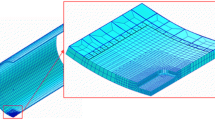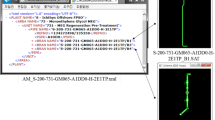Abstract
Integration of heterogeneous computer-aided design (CAD) models into shipbuilding CAD systems is necessary during ship modeling in shipyards. Vendor package models provided by equipment vendors were designed using mechanical CAD systems. Complex triangular meshes severely affect the modeling performance of shipbuilding CAD systems. Particularly, reconstructing pipe elbows from shipbuilding CAD models represented by triangular meshes is a challenging problem. We present a method to reconstruct elbow primitives for plant design management system (PDMS), a commercial shipbuilding CAD system, from a triangular mesh using mesh segmentation and elbow parameter extraction method. The mesh segmentation method divides a mesh of irregular and minimal 3D points into segments for elbow parameter extraction based on curvature and connectivity. The proposed method also extracts the parameters of an elbow using the geometric features of a partial torus. The results of the proposed method are implemented and verified using 100 test models.
Similar content being viewed by others
Abbreviations
- G :
-
Gaussian curvature
- H :
-
Mean curvature
- k max :
-
Maximum value of principal curvatures
- k min :
-
Minimum value of principal curvatures
- v :
-
Vertex
- e :
-
Edge
- VC 12 :
-
Set of vertices that correspond to the elbow end-cap
- \({{\vec n}_0}\) :
-
Direction of the axis that is orthogonal to the elbow
- \({{\vec n}_{1,2}}\) :
-
Normal vectors of the elbow end-caps
- C 0 :
-
Center of the elbow
- C 1,2 :
-
Centers of the two end-caps
- R :
-
Major radius of the elbow
- r :
-
Minor radius of the elbow
- θ 0 :
-
Angle between the two end-caps
References
Leica CloudWorx Digital Reality Plugins for CAD, Leica Geosystems, Hexagon AB, Stockholm (2021) (accessed on Jun. 22, 2021).
EdgeWise™, ClearEdge3D, Inc., Superior (2021) (accessed on Jun. 22, 2021).
H. Masuda and I. Tanaka, As-built 3D modeling of large facilities based on interactive feature editing, Computer-Aided Design and Applications, 7(3) (2010) 349–360.
T. Rabbani, F. Van Den Heuve and G. Vosselmann, Segmentation of point clouds using smoothness constraint, Int. Arch. Photogramm. Remote Sens. Spat. Inf. Sci., 36(5) (2006) 248–253.
A. Nurunnabi, Y. Sadahiro, R. Lindenbergh and D. Belton, Robust cylinder fitting in laser scanning point cloud data, Measurement, 138 (2019) 632–651.
H. Yoshioka, J. Zhu and T. Tanaka, Automatic segmentation and feature identification of laser scanning point cloud data for reverse engineering, 2016 International Symposium on Flexible Automation (ISFA), Cleveland (2016).
M. A. Fischler and R. C. Bolles, Random sample consensus: a paradigm for model fitting with applications to image analysis and automated cartography, Commun. ACM, 24(6) (1981) 381–395.
R. Schnabel, R. Wahl and R. Klein, Efficient RANSAC for point-cloud shape detection, Comput. Graph. Forum, 26(2) (2007) 214–226.
Y. Li, X. Wu, Y. Chrysathou, A. Sharf, D. Cohen-Or and N. J. Mitra, GlobFit: consistently fitting primitives by discovering global relations, ACM Trans. Graph., 30(4) (2011) 1–12.
T. T. Tran, V. T. Cao and D. Laurendeau, Extraction of reliable primitives from unorganized point clouds, 3D Res., 6(4) (2015) 1–12.
T. Rabbani and F. Van Den Heuvel, Efficient Hough transform for automatic detection of cylinders in point clouds, ISPRS WG III/3, III/4, V/3 workshop “Laser Scanning 2005”, Enschede (2005).
Y. J. Liu, J. B. Zhang, J. C. Hou, J. C. Ren and W. Q. Tang, Cylinder detection in large-scale point cloud of pipeline plant, IEEE Trans. Vis. Comput. Graph, 19(10) (2013) 1700–1707.
Y. H. Jin and W. H. Lee, Fast cylinder shape matching using random sample consensus in large scale point cloud, Appl. Sci., 9(5) (2019) 974.
G. Lukács, R. Martin and D. Marshall, Faithful least-squares fitting of spheres, cylinders, cones and tori for reliable segmentation, European Conference on Computer Vision, Freiburg (1998).
P. Benko, G. Kós, T. Várady, L. Andor and R. Martin, Constrained fitting in reverse engineering, Comput. Aided Geom. Des., 19(3) (2002) 173–205.
P. A. Fayolle and A. Pasko, Segmentation of discrete point clouds using an extensible set of templates, Vis. Comput., 29(5) (2013) 449–465.
Z. Toony, D. Laurendeau and C. Gagné, PGP2X: principal geometric primitives parameters extraction, Proceedings of the 10th International Conference on Computer Graphics Theory and Applications, Berlin (2015).
J. Li, B. C. Kim and S. Han, Parametric exchange of round shapes between a mechanical CAD system and a ship CAD system, Computer-Aided Design, 44 (2012) 154–161.
S. J. Kim, C. H. Kim and D. Levin, Surface simplification using a discrete curvature norm, Comput. Graph, 26(5) (2002) 657–663.
L. Moura and R. Kitney, A direct method for least-squares circle fitting, Comput. Phys. Commun., 64(1) (1991) 57–63.
Elbow Models, Ajou University CAD Laboratory, Suwon (2021) (accessed on Jun. 21, 2021).
Acknowledgments
This work was supported by the Basic Science Research Program through the National Research Foundation of Korea (NRF) funded by the Ministry of Education (grant number 2018R1D1A1B07050199).
Author information
Authors and Affiliations
Corresponding author
Additional information
Gun-Yeol Na is a Ph.D. candidate in the Department of Industrial Engineering at Ajou University, Suwon, Korea. He obtained his Master’s degree in Industrial Engineering in 2018 at Ajou University. His current research interests are geometric modeling, neural networks for engineering applications and virtual reality for simulation.
Jeongsam Yang is a Professor in the Department of Industrial Engineering and is leading the CAD laboratory (http://cadlab.ajou.ac.kr) at Ajou University, Korea. He worked at Carnegie Mellon University (USA) and Clausthal University of Technology (Germany) as a researcher, and the University of Wisconsin-Madison (USA) as a postdoctoral associate. He obtained his Ph.D. in Mechanical Engineering in 2004 at KAIST. His current research interests are geometry modeling, VR application in product design, image pattern analysis, 3D model reconstruction, and computer graphics.
Duhwan Mun is a Professor at the School of Mechanical Engineering at Korea University. Prior to that, he worked at the Maritime & Ocean Engineering Research Institute (MOERI) for 4 years and at Kyungpook National University for 10 years. His research interests include computer-aided design, industrial data standards, product lifecycle management, knowledge-based engineering, and virtual reality for engineering applications. He received a B.S. in Mechanical Engineering from Korea University; an M.S. and Ph.D. in Mechanical Engineering from KAIST.
Sanguk Cheon is an Assistant Professor in the Department of Integrative Systems Engineering at Ajou University. He holds a Ph.D. in Mechanical Engineering from KAIST. He has 20 years of experience in CAD system development, mainly developing shipbuilding CAD systems. His current research interests are ship/plant CAD, geometric modeling, and industrial CAD/CAM applications.
Rights and permissions
About this article
Cite this article
Na, GY., Yang, J., Mun, D. et al. Reconstruction of primitive-shaped pipe elbows from a triangular mesh in ship outfitting model. J Mech Sci Technol 35, 5551–5560 (2021). https://doi.org/10.1007/s12206-021-1126-7
Received:
Revised:
Accepted:
Published:
Issue Date:
DOI: https://doi.org/10.1007/s12206-021-1126-7




